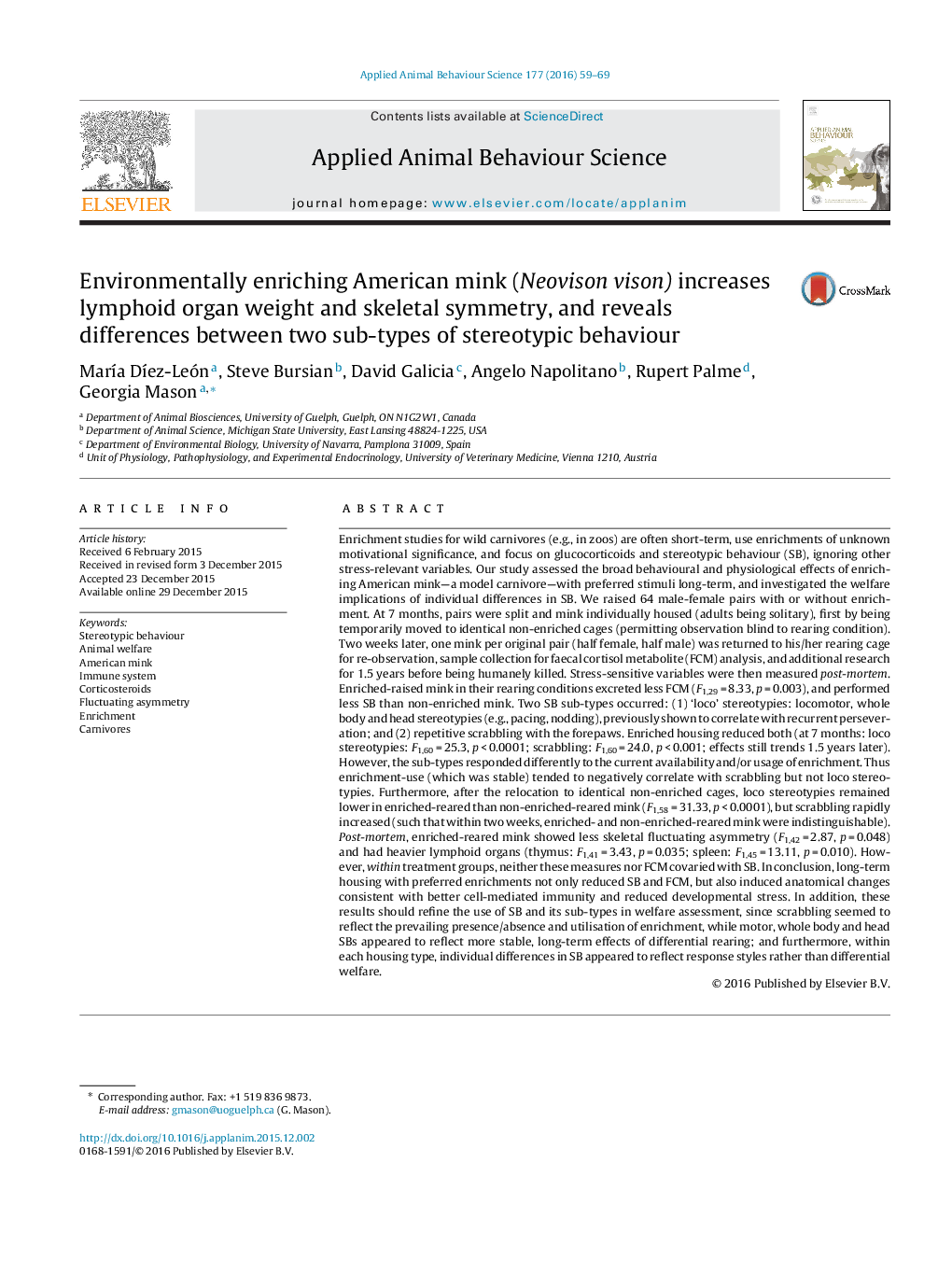| کد مقاله | کد نشریه | سال انتشار | مقاله انگلیسی | نسخه تمام متن |
|---|---|---|---|---|
| 4522429 | 1625329 | 2016 | 11 صفحه PDF | دانلود رایگان |

• We examine long-term effects of preferred enrichment in American mink.
• Enrichment reduced stereotypic behaviour and glucocorticoids.
• Enriched mink showed signs of improved immunity and reduced developmental stress.
• Within the same housing type, stereotypic behaviour and welfare did not covary.
• Subtypes of stereotypic behaviour differ in sensitivity to current housing.
Enrichment studies for wild carnivores (e.g., in zoos) are often short-term, use enrichments of unknown motivational significance, and focus on glucocorticoids and stereotypic behaviour (SB), ignoring other stress-relevant variables. Our study assessed the broad behavioural and physiological effects of enriching American mink—a model carnivore—with preferred stimuli long-term, and investigated the welfare implications of individual differences in SB. We raised 64 male-female pairs with or without enrichment. At 7 months, pairs were split and mink individually housed (adults being solitary), first by being temporarily moved to identical non-enriched cages (permitting observation blind to rearing condition). Two weeks later, one mink per original pair (half female, half male) was returned to his/her rearing cage for re-observation, sample collection for faecal cortisol metabolite (FCM) analysis, and additional research for 1.5 years before being humanely killed. Stress-sensitive variables were then measured post-mortem. Enriched-raised mink in their rearing conditions excreted less FCM (F1,29 = 8.33, p = 0.003), and performed less SB than non-enriched mink. Two SB sub-types occurred: (1) ‘loco’ stereotypies: locomotor, whole body and head stereotypies (e.g., pacing, nodding), previously shown to correlate with recurrent perseveration; and (2) repetitive scrabbling with the forepaws. Enriched housing reduced both (at 7 months: loco stereotypies: F1,60 = 25.3, p < 0.0001; scrabbling: F1,60 = 24.0, p < 0.001; effects still trends 1.5 years later). However, the sub-types responded differently to the current availability and/or usage of enrichment. Thus enrichment-use (which was stable) tended to negatively correlate with scrabbling but not loco stereotypies. Furthermore, after the relocation to identical non-enriched cages, loco stereotypies remained lower in enriched-reared than non-enriched-reared mink (F1,58 = 31.33, p < 0.0001), but scrabbling rapidly increased (such that within two weeks, enriched- and non-enriched-reared mink were indistinguishable). Post-mortem, enriched-reared mink showed less skeletal fluctuating asymmetry (F1,42 = 2.87, p = 0.048) and had heavier lymphoid organs (thymus: F1,41 = 3.43, p = 0.035; spleen: F1,45 = 13.11, p = 0.010). However, within treatment groups, neither these measures nor FCM covaried with SB. In conclusion, long-term housing with preferred enrichments not only reduced SB and FCM, but also induced anatomical changes consistent with better cell-mediated immunity and reduced developmental stress. In addition, these results should refine the use of SB and its sub-types in welfare assessment, since scrabbling seemed to reflect the prevailing presence/absence and utilisation of enrichment, while motor, whole body and head SBs appeared to reflect more stable, long-term effects of differential rearing; and furthermore, within each housing type, individual differences in SB appeared to reflect response styles rather than differential welfare.
Journal: Applied Animal Behaviour Science - Volume 177, April 2016, Pages 59–69